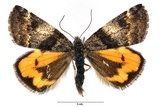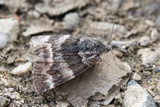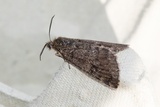Boudinotiana notha (Hübner, [1803]) Species
Last modified: Oct. 16, 2025, 11:32 a.m.
A rare and local species in Belgium, although it can be common in some years in some places, especially in the south of our country.
This species is considered Least Concern according to the IUCN Red List category for Flanders 2023.
Details
- Classification
- Family: Geometridae > Subfamily: Archiearinae > Genus: Boudinotiana > Species: Boudinotiana notha
- Vernacular names
- Oranje espenspanner (NL), Light Orange Underwing (EN), L'Illégitime (FR), Mittleres Jungfernkind, Auen-Jungfernkind (DE)
- First mention in Belgium
- De Sélys-Longchamps E. 1844. Énumération des insectes Lépidoptères de la Belgique. — Mémoires de la Société royale des Sciences de Liége 2: 1–35. On page 14. view page
- Status
-
Native
Distribution
Bionomics
The larvae are spinning a shelter among leaves by day. The moths hibernate fully developed in the pupal case, spun into soft bark, sometimes for two or three years.
The adults are active during sunny days.
No pictures yet!
Flight periods
The adults fly from mid-February, but usually from early March till late April in one generation a year.
Observed on
- Host plant (species):
- Populus tremula
The larvae feed mainly on mature Populus tremula, but sometimes also on Betula or Salix caprea.
No pictures yet!




